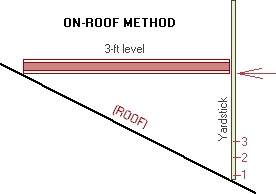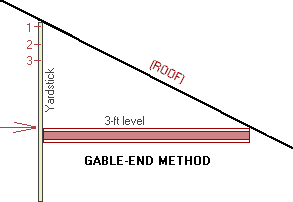
Measuring Roof Slope
Slope is defined for roofs as equal to the number of inches the roof rises ("rise") for every foot of horizontal travel ("run".) You may measure slope from a ladder at a gable, or from the roof surface itself.
-
You need
- A 3-foot level.
- A yardstick.
 |
 |
| (Numbers "1 2 3 " are shown to indicate "proper end up" for the yardstick.) | |
- Hold the yardstick tight to the end of the level (the end is square so that the level and yardstick
are at right angles.)
- Hold the level so that it's "dead level", and adjust the yardstick until it touches the roof.
- Read the yardstick (see arrow) to find the inches of slope in 3 feet (the length of the level.)
- Divide by three to get slope in inches per foot.
(Because the level is 3 feet long, you measured the rise per 36 inches. To get rise per foot, the reading must be divided by 3.)For instance, if you measured 15 inches with the yardstick, then the slope is 15 ÷ 3 = 5 inches per foot - a typical value - also termed "5 on 12" or "5/12". In "snow country" the minimum is likely to be 7/12.
- Use a special engineer's level with a built-in slope gauge.
- Use a level of a different length. The example was easy, because the the length of the level (in feet) was an integer - 3. If you use a different length, then divide the yardstick measurement by the length of the level in feet. For instance, for a 24-inch level (2 feet), divide by 2; for an 18-inch level (1.5 feet), divide by 1.5.
A yardstick is easier to use than a tape - its rigidity will make it a little easier to "fumble around with two loose sticks" while you're adjusting both tools.